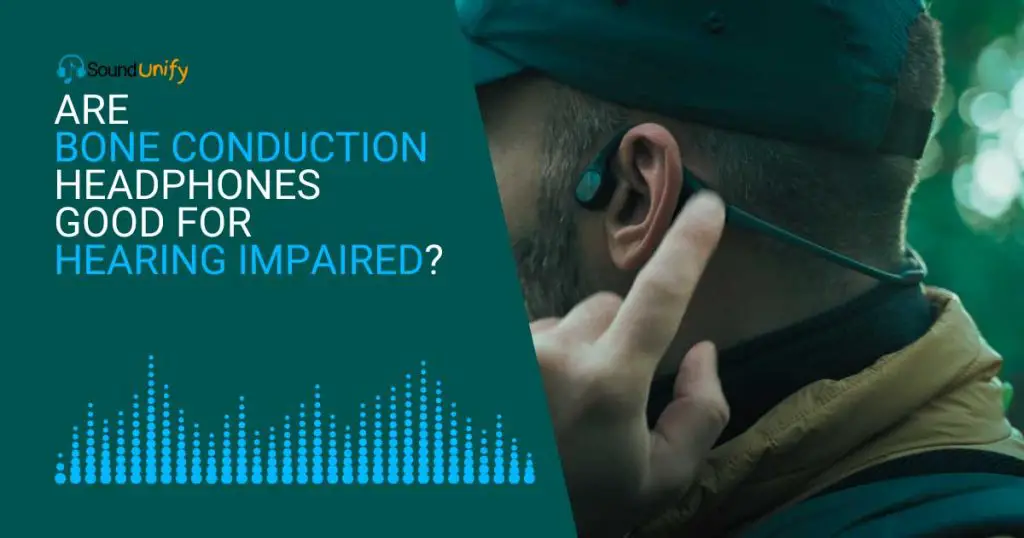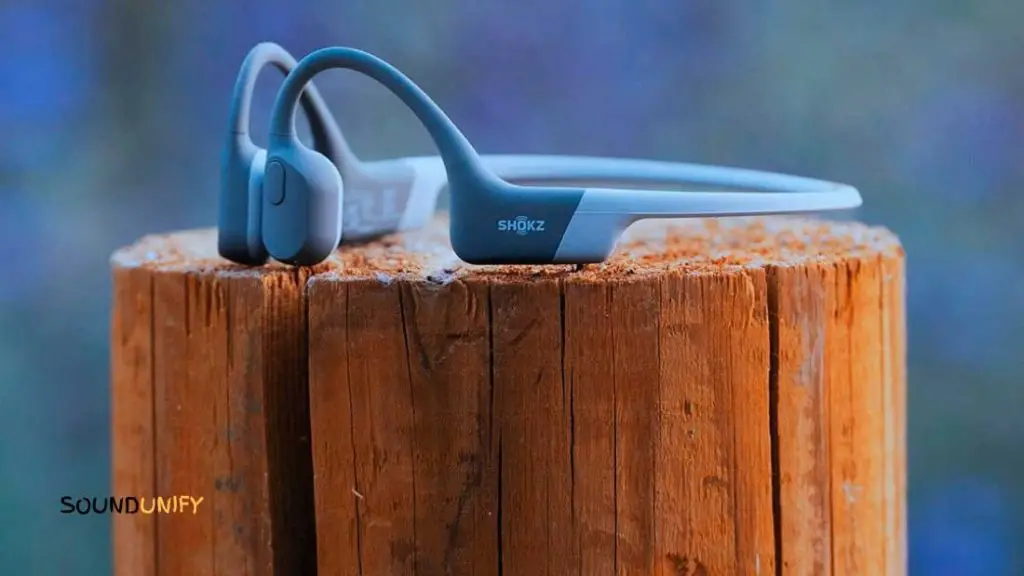Yes, bone conduction headphones can be beneficial for people with hearing impairments. They allow sound to travel through the bones of the skull directly to the inner ear, bypassing any areas of the ear with hearing loss.
Bone conduction headphones have recently gained much attention as a potential solution for those with hearing impairments. As technology continues to evolve, so do the solutions available to those with hearing loss.
Bone conduction headphones offer a unique alternative to traditional headphones. But are they viable for those with hearing impairments?
This article will explore the benefits and drawbacks of using bone conduction headphones for deaf and hard-of-hearing individuals.
We’ll discuss how bone conduction works, examine the evidence surrounding its effectiveness, and look at some tips for selecting the right pair.

How Can Bone Conduction Headphones Help Hearing Impaired People?
Bone conduction headphones allow sound to travel through the bones of the user’s skull, which bypasses the ear canal and outer ear.
This makes it ideal for individuals with hearing impairments due to inner ear damage from surgeries or illnesses and those with damaged or missing outer ear components.
The sound quality is also better for those with hearing loss due to high-frequency losses, as the sound waves can penetrate the skull more easily. Bone conduction headphones can help hearing-impaired people hear better daily and make conversations easier to manage.
Additionally, people who use hearing aids may use bone conduction headphones to reduce background noise and more easily hear speech.
Pros and Cons of Using Bone Conduction Headphones for Hearing-Impaired People

Bone conduction headphones have become increasingly popular for hearing-impaired individuals, offering numerous advantages over traditional hearing aids.
Pros
1. Bone conduction headphones are less intrusive
Bone conduction headphones transmit sound through the skull directly to the inner ear. This type of headphone is less intrusive than other types of headphones, such as earbuds inserted into the ear canal.
This makes bone conduction headphones ideal for people who want to use headphones for recreational activities like listening to music or watching videos.
2. Allow people with hearing impairments to enjoy music
Bone conduction headphones are popular for people with hearing impairments because they allow them to enjoy music without raising their voices.
Bone conduction technology transfers the sound directly through the skull and into the inner ear, bypassing the middle and outer ear.
This allows people who are deaf or have low hearing levels to enjoy high-quality sound without amplification.
3. More comfortable than standard headphones
Bone conduction headphones are more comfortable than standard headphones because the sound is transmitted directly through the bones to the ear.
This makes them a better choice for people with difficulty wearing standard headphones because they are uncomfortable or difficult to use.
4. Can be used while playing any music
Bone conduction headphones send sound vibrations through the skull and into the inner ear via the bones of your neck. This means bone conduction headphones can be used while playing any music.
They are perfect for people who want to listen to music without removing their headphones whenever they need to speak.
Additionally, bone conduction headphones are an excellent choice for people with trouble hearing in noisy environments.
5. Provide better sound quality than standard headphones
Bone conduction headphones provide better sound quality than standard headphones because they transmit sound directly to the inner ear.
People with hearing impairments can still enjoy high-quality music and audio without wearing bulky earphones.
Additionally, bone conduction headphones are less likely to cause ear infections or headaches.
6. Portable and easy to use
Bone conduction headphones are an excellent option for people who have hearing impairments. They are portable and easy to use. So you can listen to your music anywhere. Plus, they provide excellent sound quality, so you can enjoy your music without compromising quality.
7. Can be worn for a long time without any discomfort or fatigue
Bone conduction headphones use sound waves to transmit the audio signal directly to your inner ear. People with hearing impairments often use this technology because it allows them to listen to audio without using their ears.
Bone conduction headphones are usually worn over the ear and are less likely to cause discomfort or fatigue than other headphones.
8. Provide clear sound with no distortion
Bone conduction headphones are an excellent option for people who have difficulty hearing. They provide clear sound with no distortion, even in noisy environments.
This makes them perfect for people who work or live in noisy environments. They also offer a discreet listening experience perfect for people who want to listen to music or watch videos without being disturbed.
9. Work with the body’s sound waves to deliver audio
Bone conduction headphones use the body’s sound waves to deliver audio to the ears. This means they are more secure than traditional earphones because they do not rely on an external sound source.
They are also more comfortable because they do not pressure the ear canal. Bone conduction headphones are an excellent choice for people with hearing impairments because they allow them to listen to audio without having to remove their headphones.
10. They can be used with any hearing aid
Bone conduction headphones are an excellent option for people who have trouble hearing. They can be used with any hearing aid and are often more comfortable than traditional earbuds.
Bone conduction headphones transmit sound through the bones in your skull, which means they can be used when listening to music or watching a video.
Cons
Potential Cons of Using Bone Conduction Headphones for Hearing-Impaired People:
1. The headphones will not work with all hearing aids
Another potential downside to bone conduction headphones is that they will not work with all hearing aids. If you have a traditional hearing aid, the headphones will amplify the sound too much, making it difficult to hear anything else.
The headphones will not work if you have a cochlear implant. You must use traditional analog or digital hearing aids to use bone conduction headphones effectively.
2. The headphones will not work in noisy environments
Another potential con of bone conduction headphones is that they will not work in noisy environments. This means that if you are trying to listen to music or watch a movie in a noisy setting, the headphones will not work.
The headphones use acoustic waves to send sound directly into your ear canal. If there is too much noise, the sound will be blocked, and the headphones will not work.
3. The headphones may cause discomfort or irritation
Some people with hearing impairment use bone conduction headphones instead of conventional earbuds because they are more comfortable. However, research has shown that these headphones may cause discomfort or irritation.
If you are using bone conduction headphones, it is essential to take the time to test them out before making a purchase. A different type of earbud may be more suitable for your needs.
4. They can be expensive
One of the people’s biggest concerns about bone conduction headphones is their cost. Bone conduction headphones use tiny microphone sensors placed on the ear canal’s front.
These sensors send sound vibrations directly to your inner ear, bypassing the external ear canals.
As a result, bone conduction headphones are much more effective than regular headphones for hearing-impaired people. However, they can be expensive.
Can Bone Conduction Headphones Help People with Hearing Loss?

People with hearing loss can benefit from using bone conduction headphones. Research suggests that bone conduction headphones can improve speech recognition in people with mild-to-severe hearing loss, depending on their impairment.
Studies also show that headphones can reduce mishearing words or misunderstanding conversations. There is some evidence that they can even help those with profound hearing loss understand some spoken words.
In addition, evidence suggests that wearing bone conduction headphones can increase overall satisfaction among users compared to other hearing aids. This includes ease of use and comfort when listening to audio content such as music or podcasts.
Tips for Selecting the Right Pair of Bone Conduction Headphones
When it comes to selecting the right pair of bone conduction headphones for deaf and hard of hearing individuals, there are a few key factors that should be taken into account.
- Comfort is paramount since these headphones rest directly against the head or ears and may cause discomfort if they are too tight or loose. Selecting a pair with adjustable headbands, ear cushions, and boom microphones that provide a secure fit while allowing flexibility is essential.
- Sound quality is also extremely important when selecting bone conduction headphones for people with hearing loss. While these headphones can provide sound clarity, it’s important to ensure that the sound produced is at an appropriate volume level and does not cause additional strain on the ears due to high volumes. Additionally, certain features, such as noise cancellation, can help reduce background noise and ensure sound is clear and balanced.
- Battery life should be considered when purchasing bone conduction headphones, as hearing-impaired individuals may require more extended listening than others. Look for models with long-lasting batteries that provide up to 10 hours of continuous listening time on a single charge.
- It is also essential to select a model that can provide clear sound. Choose a model with high-quality speakers that can handle frequencies up to 20,000 Hz. Also, look for models with enhanced bass and mids for better sound quality.
Overall, selecting the right pair of bone conduction headphones for people with hearing loss will require research and comparison shopping to find a product that meets all their needs while providing optimal comfort and sound quality.
FAQ
Can bone conduction headphones hurt your hearing?
Bone conduction headphones have several potential risks associated with them. There is potential for long-term hearing damage because the headphones vibrate the bones of the skull directly instead of creating sound waves outside the ear canal.
Additionally, the headphones can cause ear ringing or temporary hearing loss if used at too high of a volume or for too long. On the other hand, the technology is much safer than traditional headphones to prevent loud sounds from directly hitting the ear, making it an appropriate choice for those with hearing difficulties.
Ultimately, if the user is careful to keep within safe limits of sound volume and duration of use, there is probably not a significant risk from wearing these headphones.
Does AfterShokz work with hearing loss?
Yes, AfterShokz bone conduction headphones can help those with hearing loss. AfterShokz headphones are designed to transmit sound waves through your cheekbones to your inner ear. This allows users to listen to the sound even with hearing impairment or hearing loss.
Additionally, AfterShokz premium audio technology offers a great and comfortable listening experience.
Can the deaf hear with bone conduction headphones?
Yes, people who are entirely deaf can hear with bone conduction headphones.
Bone conduction headphones allow sound waves to travel through the bones of the user’s skull, bypassing the ear canal and outer ear.
This makes it ideal for individuals with hearing impairments due to inner ear damage from surgeries or illnesses and those with damaged or missing outer ear components.
Sound quality is often better for those with hearing loss due to high-frequency losses, as the sound waves can penetrate the skull more effectively.
Are bone conduction headphones safer for jogging near cars?
Bone conduction headphones are a much safer alternative while jogging near cars. Since they send sound waves directly to the inner ear, they make it easier to hear your surroundings, such as passing cars.
Using regular over-ear headphones makes it almost impossible to listen to your surroundings. This can be especially dangerous if you are jogging on a busy road.
Bone conduction headphones are also safer for your hearing as they reduce the risk of hearing damage from loud noises.
Conclusion
For the right pair of bone conduction headphones, they can work wonders for people with hearing impairment.
Just like regular headphones, they do not emit sound. For those still unsure about their suitability, consult your doctor before using them.
After reading this article? We bet you now have more information to make a well-informed decision! If not? We suggest you head to your local store and try a few pairs.
James Dimento is a Chief-in-Editor of SoundUnify. He is a headphone enthusiast and creative writer passionate about audio technology. He has three years of experience writing about headphones and sound quality and is responsible for creating reviews and taking care of all administration.
